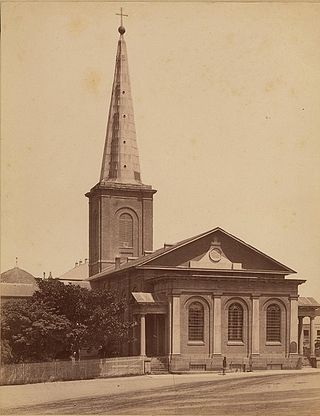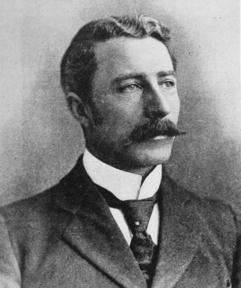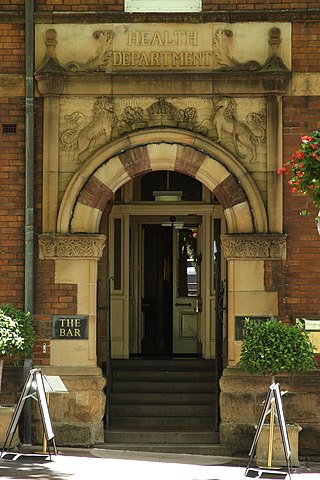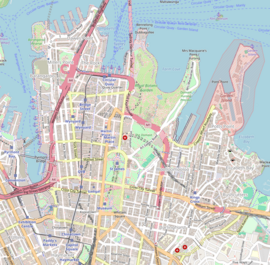
The Sydney Conservatorium of Music is a heritage-listed music school in Macquarie Street, Sydney, New South Wales, Australia. It is one of the oldest and most prestigious music schools in Australia. Located adjacent to the Royal Botanic Gardens on the eastern fringe of the Sydney central business district, the conservatorium is a faculty of the University of Sydney, and incorporates the community-based Conservatorium Open Academy and the Conservatorium High School. In addition to its secondary, undergraduate, post-graduate and community education teaching and learning functions, the conservatorium undertakes research in various fields of music. The building was added to the New South Wales State Heritage Register on 14 January 2011.

The New South Wales Government Architect, an appointed officer of the Government of New South Wales, serves as the General Manager of the Government Architect's Office (GAO), a multi-disciplinary consultancy operating on commercial principles providing architecture, design, and engineering services, that is an agency of the government within NSW Public Works.

Castlereagh Street is a 1.6-kilometre-long (1 mi) major street located in the Sydney central business district in New South Wales, Australia. The street runs in a north-to-south, in a one way direction only.

The Parliament House in Sydney is a heritage-listed complex of buildings housing the Parliament of the state of New South Wales, Australia. The building is located on the east side of Macquarie Street in Sydney, the state capital. The façade consists of a two-storey Georgian building, the oldest public building in the City of Sydney, flanked by two Neo-gothic additions containing the parliamentary chambers. These buildings are linked to a 1970s 12-storey block at the rear, facing onto the Domain. It is also known as Parliament of New South Wales, Parliamentary Precincts and the Rum Hospital.

The Department of Education building is a heritage-listed state government administrative building of the Edwardian Baroque architectural style located in Bridge Street in the Sydney central business district in the City of Sydney local government area of New South Wales, Australia. The large public building was designed by Colonial Architect George McRae and built in two stages, the first completed in 1912, with John Reid and Son completing the second stage in 1938. It is also known as the Department of Education Building and the Education Building. The property was added to the New South Wales State Heritage Register on 2 April 1999.

The Chief Secretary's building is a heritage-listed state government administrative building of the Victorian Free Classical architectural style located at 121 Macquarie Street, 65 Bridge Street, and at 44-50 Phillip Street in the Sydney central business district of New South Wales, Australia. The ornate five-storey public building was designed by Colonial Architect James Barnet and built in two stages, the first stages being levels one to four completed between 1873 and 1881, with Walter Liberty Vernon completing the second stage between 1894 and 1896 when the mansard at level five and the dome were added.

Mortimer William Lewis was an English-born architect, surveyor and public servant who migrated to Australia and became Colonial Architect in the colony of New South Wales from 1835 to 1849. Lewis was responsible for designing and overseeing many government buildings in Sydney and rural New South Wales, many of which are heritage listed.

George McRae was a Scottish-Australian architect who migrated from his native Edinburgh to Sydney, where he became Government Architect of New South Wales and designed some of Sydney's best-known buildings, including completion of the Sydney Town Hall, the Queen Victoria Building, and the lower entrance to Taronga Zoo.

The Department of Lands building is a heritage-listed state government administrative building of the Victorian Renaissance Revival architectural style located in Bridge Street in the Sydney central business district of New South Wales, Australia. The large three-storey public building was designed by Colonial Architect James Barnet and built in different stages, with Walter Liberty Vernon and William Edmund Kemp designing various components of the building. The builder was John Young.

Bridge Street is a street in the central business district of Sydney in New South Wales, Australia. Bridge Street runs for 500 metres (1,600 ft) in a west–east direction with traffic flowing in both directions. It is situated in the northern portion of the central business district. The western terminus of Bridge Street is at George Street, with the eastern terminus at Macquarie Street, adjacent to the Chief Secretary's Building. From west to east, Bridge Street crosses Pitt and Phillip streets.

The Justice and Police Museum is a heritage-listed former water police station, offices and courthouse and now justice and police museum located at 4-8 Phillip Street on the corner of Albert Street, in the Sydney central business district in the City of Sydney local government area of New South Wales, Australia. It was designed by Edmund Blacket, Alexander Dawson and James Barnet and built from 1854 to 1886. It is also known as Police Station & Law Courts (former) and Traffic Court. The property is owned by the Department of Justice, a department of the Government of New South Wales. It was added to the New South Wales State Heritage Register on 2 April 1999.

St Mary's Anglican Church is a heritage-listed Anglican church and associated facilities located at 240 Birrell Street, Waverley, in the Waverley Municipality, Sydney, New South Wales, Australia. The church was designed by Edmund Blacket and built between 1863 and 1864. It is very well known and sought after as a place to be married and is popular for funerals. The building is also notable due its pipe organ, designed and built by August Gern. The property is used for ministry by the Anglican Parish of Bondi and Waverley, which is an amalgamation of two previous Parishes ; The first Rector of St Mary’s Waverley, Rev Stanley Mitchell, was a keen Evangelical and although he used traditional Anglican liturgy was “low church” like most of Sydney Diocese. However there has been a long history of more “High” Anglicanism and Anglo Catholic theological underpinnings. Since 2014, the church has returned to a strongly evangelical base while running a very strong traditional 1662 prayer book communion service every Sunday. It also has less traditional al services to accommodate more contemporary congregations.

St Matthew's Anglican Church is a heritage-listed Anglican church building located at Moses Street, Windsor, City of Hawkesbury, New South Wales, Australia. It was designed by Francis Greenway and built from 1817 by convict labour. The property is owned by the Anglican Church Property Trust. It was added to the New South Wales State Heritage Register on 2 April 1999.

St John's Anglican Church and Macquarie Schoolhouse is a heritage-listed Anglican church building and church hall located at 43-43a Macquarie Road, Wilberforce, City of Hawkesbury, New South Wales, Australia. The church was designed by Edmund Blacket and built from 1819 to 1859 by James Atkinson, senior; and the schoolhouse was built by John Brabyn. The church is also known as the St. John's (Blacket) Church, while the hall is also known as the Macquarie Schoolhouse/Chapel and the Wilberforce Schoolhouse. It was added to the New South Wales State Heritage Register on 20 August 2010.

Jenner House is a heritage-listed residence located at 2 Macleay Street in the inner city Sydney suburb of Potts Point in the City of Sydney local government area of New South Wales, Australia. It was designed by Edmund Blacket and built in 1871, with an 1877 third-floor addition designed by Thomas Rowe. It has also been known as Fleet Club, Stramshall, Jenner Private Hospital, Kurragheen and Lugano. It was added to the New South Wales State Heritage Register on 2 April 1999.

The Brooklyn Hotel is a heritage-listed bar, restaurant and former hotel located at 229 George Street, in the suburb of The Rocks, in the city of Sydney, New South Wales, Australia. It was designed by Walter Liberty Vernon and built in 1912. The property is owned by Property NSW, an agency of the Government of New South Wales. It was added to the New South Wales State Heritage Register on 10 May 2002.

182 Cumberland Street, The Rocks is a heritage-listed retail building and residence located at 182 Cumberland Street, in the inner city Sydney suburb of The Rocks in the City of Sydney local government area of New South Wales, Australia. It was designed by Walter Liberty Vernon with the assistance of E. L. Drew and built from 1911 to 1912. The property is owned by Property NSW, an agency of the Government of New South Wales. It was added to the New South Wales State Heritage Register on 10 May 2002.

107–109 George Street, The Rocks is a heritage-listed restaurant and former retail building, residence and bakery located at 107–109 George Street, in the inner city suburb of The Rocks in the City of Sydney local government area of New South Wales, Australia. It was built during 1860. It is also known as Rockpool Restaurant (former); and William Blue Dining. The property is owned by Property NSW, an agency of the Government of New South Wales. It was added to the New South Wales State Heritage Register on 10 May 2002.

93–97 Macquarie Street, Sydney or formerly the Health Department building is a heritage-listed former government office, health clinic and hospital admissions depot and now hotel at 93–97 Macquarie Street, in the Sydney central business district, in the City of Sydney local government area of New South Wales, Australia. It was designed by Walter Liberty Vernon and NSW Government Architect and built from 1896 to 1898. It is currently part of the Sir Stamford Hotel, which formerly was a Ritz Carlton Hotel. In its history it has also been used as the Venereal Disease Clinic, STD Clinic, Hospital Admissions Depot and Former Health Board Offices. It was added to the New South Wales State Heritage Register on 9 October 2013.

St Peter's Anglican Church is a heritage-listed Anglican church and associated Sunday school, rectory, and cemetery at 384 Windsor Street, Richmond, City of Hawkesbury, New South Wales, Australia. It was designed by Francis Clarke and Edmund Blacket and built from 1836 to 1841 by James Atkinson (church). It is also known as St Peter's Anglican Church Group, St Peter's Church Group, Church, Rectory, Church Yard, Cemetery and Stables. It was added to the New South Wales State Heritage Register on 16 August 2019; and on the City of Hawkesbury local government heritage register, and listed on the New South Wales Heritage Database on 12 September 2012.





















